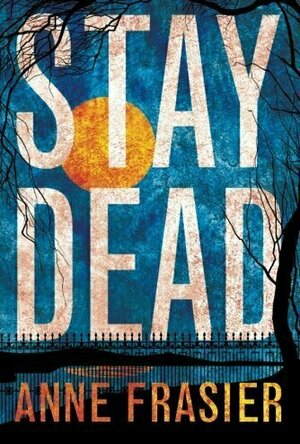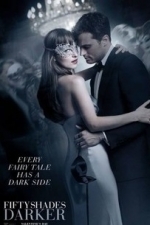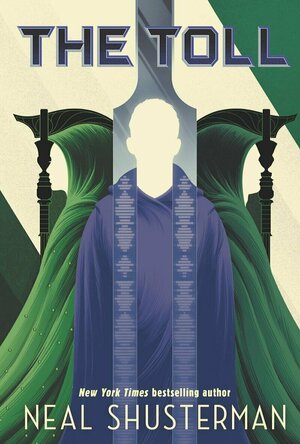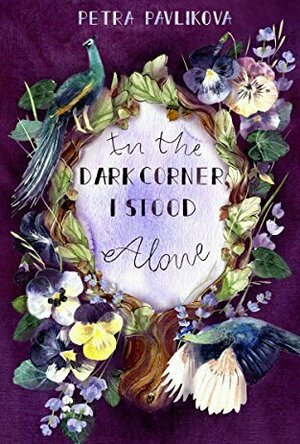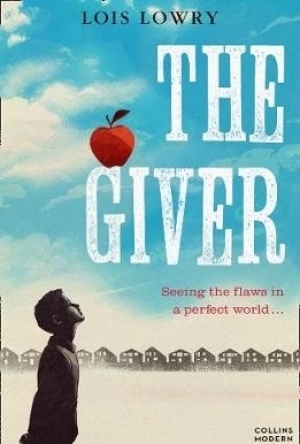Search
Lyndsey Gollogly (2893 KP) rated Stay Dead (Elise Sandburg #2) in Books
Aug 12, 2020
Contains spoilers, click to show
146 of 200
Kindle
Stay Dead ( Elise Savannah book 2)
By Anne Frasier
Frasier takes readers back to her dark, enchanting Savannah--a place as terrifying as it is mesmerizing.
Homicide detective Elise Sandburg is traumatized after her run-in with a madman the press has dubbed "The Organ Thief." As Elise takes refuge in her deceased aunt Anastasia's abandoned plantation to investigate and recover from her ordeal, she begins to question everything--from her dangerous line of work to her complex relationship with her handsome, tortured partner, David Gould. But with a madman on the loose, and her mother's claims to still hear from Aunt Anastasia, she may have more immediate problems on her hands. In Elise's world, where cold hard crime mixes with the local Gullah culture, nothing is ever what it seems, and no one is above suspicion--not even the dead.
This is book 2 in the series and it was brilliant! The story continues from book 1 with the mystery surrounding not only the murders but the so called murderer waking and walking away from a coma. Elise is not yet recovered before she’s back up and chasing the organ thief, as well as dealing with two major back from the dead family members, the growing feelings for Gould and the daughter that won’t do as she’s told!! The writing is just brilliant a thriller with a touch of possible voodoo witchcraft!
Kindle
Stay Dead ( Elise Savannah book 2)
By Anne Frasier
Frasier takes readers back to her dark, enchanting Savannah--a place as terrifying as it is mesmerizing.
Homicide detective Elise Sandburg is traumatized after her run-in with a madman the press has dubbed "The Organ Thief." As Elise takes refuge in her deceased aunt Anastasia's abandoned plantation to investigate and recover from her ordeal, she begins to question everything--from her dangerous line of work to her complex relationship with her handsome, tortured partner, David Gould. But with a madman on the loose, and her mother's claims to still hear from Aunt Anastasia, she may have more immediate problems on her hands. In Elise's world, where cold hard crime mixes with the local Gullah culture, nothing is ever what it seems, and no one is above suspicion--not even the dead.
This is book 2 in the series and it was brilliant! The story continues from book 1 with the mystery surrounding not only the murders but the so called murderer waking and walking away from a coma. Elise is not yet recovered before she’s back up and chasing the organ thief, as well as dealing with two major back from the dead family members, the growing feelings for Gould and the daughter that won’t do as she’s told!! The writing is just brilliant a thriller with a touch of possible voodoo witchcraft!
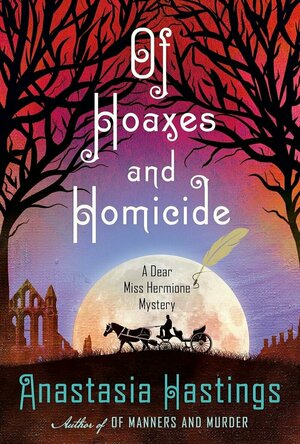
Of Hoaxes and Homicide
Book
The second in the delightful Dear Miss Hermione mystery series from Anastasia Hastings—when you...
Gareth von Kallenbach (980 KP) rated Fifty Shades Darker (2017) in Movies
Jun 19, 2019
Anastasia Steele (Dakota Johnson) and Christian Grey (Jamie Dornan) have returned in “50 Shades Darker” which looks to continue the massive success of the series.
Picking up shortly after the last film, the newly single Anastasia has begun working her dream job as an assistant in a Seattle publishing company. When she is reunited with Christian at a social event, he pleads with her to take him back and offers to redefine the terms of their relationship agreement.
Although cautions, she takes him back and despite telling him she wants to take it slow, the first of many sex scenes follow.
Although happy to be reunited, the pair are plagued by issues from Christian’s past as well as his own inner demons which constantly pull at them and threaten to undermine their new relationship.
Of course much if it is little more than thinly veiled lip service designed to get them into the bedroom time and time again so the camera can focus on their bodies and Christian resorting to his old ways with all manner of restraints and devices.
One would think that a film that is supposed to be so erotic would be far more exciting and titillating but the film’s sex scenes are so dull and by the numbers you will soon find yourself losing interest. A big part of this goes to the total lack of chemistry between the leads. If you thought it was strained in the first film it is pretty much non-existent this time out. The dialogue is also not much better as it is laughably bad in areas and unintentionally funny. The monotone delivery of the leads does not help much as it seems like there is a competition to see how many shots of the beautiful Seattle area and their bodies can be creamed into the film.
Kim Bassinger does bring the film a bit of intrigue as a woman from Christian’s past, but she is not in the film enough to really make that much of a difference as pretty much all of the supporting characters are paper thin and not given the chance to grow.
I did like the film more than I liked the original film, but I continue to struggle with the appeal of the film series. The leads lack any chemistry and supporters of the BDSM lifestyle have said the series does not portray their lifestyle accurately and that what Christian does is abusive.
I posted the question that how much appeal would the series have if Christian was a struggling musician living in a hovel who could not even afford a Starbucks run. He would be considered a deeply damaged individual who women would run from. But package him up as a young and attractive billionaire, and it seems that common sense goes out the window as far as the ladies in his life go, and he gets a pass on behaviors that would be totally unacceptable to most.
For me the lack of eroticism, chemistry between the leads, and a compelling story could be overlooked as despite the issues, it does entertain. But when the characters are so hard to like, I found myself not having much sympathy for any obstacles they encountered. My advice, wait for the video as there are far more erotic and entertaining films on Netflix.
http://sknr.net/2017/02/09/50-shades-darker/
Picking up shortly after the last film, the newly single Anastasia has begun working her dream job as an assistant in a Seattle publishing company. When she is reunited with Christian at a social event, he pleads with her to take him back and offers to redefine the terms of their relationship agreement.
Although cautions, she takes him back and despite telling him she wants to take it slow, the first of many sex scenes follow.
Although happy to be reunited, the pair are plagued by issues from Christian’s past as well as his own inner demons which constantly pull at them and threaten to undermine their new relationship.
Of course much if it is little more than thinly veiled lip service designed to get them into the bedroom time and time again so the camera can focus on their bodies and Christian resorting to his old ways with all manner of restraints and devices.
One would think that a film that is supposed to be so erotic would be far more exciting and titillating but the film’s sex scenes are so dull and by the numbers you will soon find yourself losing interest. A big part of this goes to the total lack of chemistry between the leads. If you thought it was strained in the first film it is pretty much non-existent this time out. The dialogue is also not much better as it is laughably bad in areas and unintentionally funny. The monotone delivery of the leads does not help much as it seems like there is a competition to see how many shots of the beautiful Seattle area and their bodies can be creamed into the film.
Kim Bassinger does bring the film a bit of intrigue as a woman from Christian’s past, but she is not in the film enough to really make that much of a difference as pretty much all of the supporting characters are paper thin and not given the chance to grow.
I did like the film more than I liked the original film, but I continue to struggle with the appeal of the film series. The leads lack any chemistry and supporters of the BDSM lifestyle have said the series does not portray their lifestyle accurately and that what Christian does is abusive.
I posted the question that how much appeal would the series have if Christian was a struggling musician living in a hovel who could not even afford a Starbucks run. He would be considered a deeply damaged individual who women would run from. But package him up as a young and attractive billionaire, and it seems that common sense goes out the window as far as the ladies in his life go, and he gets a pass on behaviors that would be totally unacceptable to most.
For me the lack of eroticism, chemistry between the leads, and a compelling story could be overlooked as despite the issues, it does entertain. But when the characters are so hard to like, I found myself not having much sympathy for any obstacles they encountered. My advice, wait for the video as there are far more erotic and entertaining films on Netflix.
http://sknr.net/2017/02/09/50-shades-darker/
A Bibliophagist (113 KP) rated The Toll (Arc of a Scythe, #3) in Books
Feb 5, 2020
Characters (3 more)
Worldbuilding
Plot
Pacing
A fantasic finale
After the amazing cliffhanger of Thunderhead, I rushed to pick up this because I just HAD TO KNOW. This cover is even prettier, they really nailed this series (sans the transformers font) and I hope it inspires more YA books to hire illustrators and not photo manip garbage. I'm an Illustrator though, so I'm biased. This review will have spoilers for Thunderhead, so don't read if you haven't read that!
The Toll picks up immediately after Thunderhead. Goddard has returned the MidMerica, no one knows that he was demoted to apprentice and with the death of Scythe Curie he stands uncontested for replacing Xenocrates. Anastasia and Rowan rest at the bottom of the ocean, and Goddard has made the site a site of remembrance to avoid any evidence being drudged up. The sinking of Endura is also squarely blamed on Rowan, and the world suffers as the Thunderhead punishes everyone, marking them unsavory. Cutting off communication with all but one, our former unsavory, Greyson.
With the rise of Goddard, the Schism amongst the Scythedom widens. He seizes more power, overturns rules and makes new ones and slowly starts taking control of other nations. Dubbing himself the Overblade. The story arches over 3 years post Thunderhead, and we jump around a little bit. During the three years Goddard continues to take a chokehold on the world, Greyson suddenly finds himself a living god amongst the tonists and humanity, as the only one able to speak to the thunderhead, he takes on the role of the Tonist's mythological figure, The Toll. Acting as a go-between, and manipulating those around him to fulfill the Thunderhead's goals.
Meanwhile, Faraday continues his search for the land of nod, making serious headway and discovering something that makes the Thunderhead uncertain. So the Thunderhead starts making plans. Faraday finds himself stranded with his helper, far away from the Scythedom, the Thunderhead and the horrible things that have been happening far away. He knows nothing of the fate of Marie, Goddard, Citra, Rowan, or the world. Finally, in the third year since the sinking of Endura, Rowan and Citra are raised from the depths, squirreled away by the Amazonian Scythes before Goddard knows they aren't dead. Being raised from the dead did wonders for Goddard's cause, so can Anastaisa's return do wonders for the plight of the old guard? But first Anastasia must plan and play her cards right, digging deep in the Thunderheads back brain to piece together mysteries long since written off and uncover the secrets of the Scythedom.
This book was really good, and a very satisfying finale to the series. The already rich worldbuilding is made richer by his choice to cut the world off from the Thunderhead, showing us what happens when people lose their connection to the world. He believably shows the influence one charismatic politician can have, and how easy it is for things to fall into disarray. You can tell he had a gameplan when he wrote these books, because everything comes together just right, not loose ends, everything had a purpose. Characters are tested, grow and develop. New parts of the world are further explored, completing the picture he begun in the other two books. I thoroughly enjoyed his take on the age-old sci-fi trope of "How does the benevolent computer protect humans from themselves". Well written, and elevated, especially in terms of other YA fiction. Shusterman really wrote a fantastic series. Once again, the romance is understated, but the emotions run deep enough at this point to pull at your heartstrings and make you believe in their love, even if it came from somewhat unbelievable beginnings.
This series is well worth the read, and a breath of fresh air in an otherwise stale and formulaic YA world.
The Toll picks up immediately after Thunderhead. Goddard has returned the MidMerica, no one knows that he was demoted to apprentice and with the death of Scythe Curie he stands uncontested for replacing Xenocrates. Anastasia and Rowan rest at the bottom of the ocean, and Goddard has made the site a site of remembrance to avoid any evidence being drudged up. The sinking of Endura is also squarely blamed on Rowan, and the world suffers as the Thunderhead punishes everyone, marking them unsavory. Cutting off communication with all but one, our former unsavory, Greyson.
With the rise of Goddard, the Schism amongst the Scythedom widens. He seizes more power, overturns rules and makes new ones and slowly starts taking control of other nations. Dubbing himself the Overblade. The story arches over 3 years post Thunderhead, and we jump around a little bit. During the three years Goddard continues to take a chokehold on the world, Greyson suddenly finds himself a living god amongst the tonists and humanity, as the only one able to speak to the thunderhead, he takes on the role of the Tonist's mythological figure, The Toll. Acting as a go-between, and manipulating those around him to fulfill the Thunderhead's goals.
Meanwhile, Faraday continues his search for the land of nod, making serious headway and discovering something that makes the Thunderhead uncertain. So the Thunderhead starts making plans. Faraday finds himself stranded with his helper, far away from the Scythedom, the Thunderhead and the horrible things that have been happening far away. He knows nothing of the fate of Marie, Goddard, Citra, Rowan, or the world. Finally, in the third year since the sinking of Endura, Rowan and Citra are raised from the depths, squirreled away by the Amazonian Scythes before Goddard knows they aren't dead. Being raised from the dead did wonders for Goddard's cause, so can Anastaisa's return do wonders for the plight of the old guard? But first Anastasia must plan and play her cards right, digging deep in the Thunderheads back brain to piece together mysteries long since written off and uncover the secrets of the Scythedom.
This book was really good, and a very satisfying finale to the series. The already rich worldbuilding is made richer by his choice to cut the world off from the Thunderhead, showing us what happens when people lose their connection to the world. He believably shows the influence one charismatic politician can have, and how easy it is for things to fall into disarray. You can tell he had a gameplan when he wrote these books, because everything comes together just right, not loose ends, everything had a purpose. Characters are tested, grow and develop. New parts of the world are further explored, completing the picture he begun in the other two books. I thoroughly enjoyed his take on the age-old sci-fi trope of "How does the benevolent computer protect humans from themselves". Well written, and elevated, especially in terms of other YA fiction. Shusterman really wrote a fantastic series. Once again, the romance is understated, but the emotions run deep enough at this point to pull at your heartstrings and make you believe in their love, even if it came from somewhat unbelievable beginnings.
This series is well worth the read, and a breath of fresh air in an otherwise stale and formulaic YA world.

SEPHORA – Maquillage, Parfum & Beauté
Shopping and Lifestyle
App
Cette application vous permet de sublimer votre expérience shopping et de faire le plein de beauté...

SEPHORA – Make-Up, Profumi e Bellezza
Shopping and Lifestyle
App
Questa applicazione renderà la tua shopping experience ancora più piacevole, permettendoti di fare...
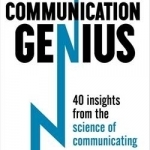
Communication Genius: 40 Insights from the Science of Communicating
Book
The fast-track MBA in communication Imagine having instant access to the world's smartest thinking...
Gareth von Kallenbach (980 KP) rated Fifty Shades of Grey (2015) in Movies
Aug 6, 2019
remember thinking, after reading the first couple of chapters of Fifty Shades of Grey two years ago, “Is this guy a vampire?” E.L. James’ description of Christian Grey brought to mind Edward of the Twilight series and the heroine, Anastasia Steele’s clumsy entrance into Grey’s office reminded me of Bella. I was so certain I would find out Grey was a vampire in the following chapters.
So it wasn’t too much of a surprise for me when I learned the book started out as Twilight fan fiction. The hero and heroine were clearly patterned after Bella and Edward. So whenever someone asked me what the book was about, I would tell them, “It’s an awfully written Twilight with a lot of sex and some bondage and spanking. “ That being said, I’m hardly a book snob. I’ll read just about anything, and while I may complain the whole time, I’ll finish the series if one exists. But even casual readers should be able to recognize badly written fiction when it smacks them in the face like Fifty Shades of Grey.
When I heard they were making a movie, I figured it would be a Rated R or NC-17 version Twilight. I played the game along with other millions of women on who should be the leads. I picked Anna Kendrick and Ian Somerhalder. I wasn’t too disappointed with the actual picks (I think that required actually caring), but the trailers did not endear Dakota Johnson to me at all. On the way to the screener, I joked with my husband, Gareth, that I expected to see Dakota Johnson and Jamie Dornan doing a lot of gasping or scowling with mouth agape since that seemed to be their go-to reactions in the book. (James is fond of writing about jaw-drops and sharp intakes of breath in her books).
I had to make him promise to refrain from making Mystery Science Theater 3000 commentary during the movie, but within the first 5 minutes he recognized some landmarks and leaned over to ask “Wait. She went to WSU?” When I nodded, Gareth, a proud UW Husky, leaned back, shook his head and muttered, “Already disappointed.” We both actually enjoyed seeing the Seattle backdrop, all shiny and urbane, at least in Grey’s world. I thought Gareth was talking about the ridiculousness of Christian Grey’s wealth when he whispered, “This movie is so full of it.” I raised my eyebrows at him and he said, “You know you can’t find parking that easily in Seattle.”
Being familiar with the books, I knew what to expect and for the most part, director Sam Taylor-Johnson, greatly improved on weak source material. Dakota Johnson was a pleasant surprise, making Anastasia smart, witty and much more relatable than the book Ana. Jamie Dornan was very easy to look at. Listening to? Not so much. It’s been reported that E. L. James’ insisted the dialogue from her books remain unchanged. One wonders if she also insisted Dornan deliver his parts as if he were reading her book. Reluctantly and under great duress.
Fans of the books will notice a few changes, and of course it won’t be as graphic as the book, but there are at least 25 minutes of steamy scenes. All in all, this may be one of those rare times the movie is better than the book. Like the books, now that I’m invested, I will watch the next two in the trilogy. Mainly thanks to Dakota Johnson. If nothing else, I have to give Fifty Shades of Grey credit for inspiring passion – in debates about abusive relationships, true BDSM and the age-old bad boy vs. good men attraction. I don’t think I’ve engaged in this many debates with friends and coworkers about a non-sci-fi movie before. It could very well inspire all kinds of other passion for those who give in and escort their significant other to this movie this weekend. But hopefully, unlike the leads in the movie, those inspired will reach a satisfying finish rather than a stylized fade-out to the morning after.
So it wasn’t too much of a surprise for me when I learned the book started out as Twilight fan fiction. The hero and heroine were clearly patterned after Bella and Edward. So whenever someone asked me what the book was about, I would tell them, “It’s an awfully written Twilight with a lot of sex and some bondage and spanking. “ That being said, I’m hardly a book snob. I’ll read just about anything, and while I may complain the whole time, I’ll finish the series if one exists. But even casual readers should be able to recognize badly written fiction when it smacks them in the face like Fifty Shades of Grey.
When I heard they were making a movie, I figured it would be a Rated R or NC-17 version Twilight. I played the game along with other millions of women on who should be the leads. I picked Anna Kendrick and Ian Somerhalder. I wasn’t too disappointed with the actual picks (I think that required actually caring), but the trailers did not endear Dakota Johnson to me at all. On the way to the screener, I joked with my husband, Gareth, that I expected to see Dakota Johnson and Jamie Dornan doing a lot of gasping or scowling with mouth agape since that seemed to be their go-to reactions in the book. (James is fond of writing about jaw-drops and sharp intakes of breath in her books).
I had to make him promise to refrain from making Mystery Science Theater 3000 commentary during the movie, but within the first 5 minutes he recognized some landmarks and leaned over to ask “Wait. She went to WSU?” When I nodded, Gareth, a proud UW Husky, leaned back, shook his head and muttered, “Already disappointed.” We both actually enjoyed seeing the Seattle backdrop, all shiny and urbane, at least in Grey’s world. I thought Gareth was talking about the ridiculousness of Christian Grey’s wealth when he whispered, “This movie is so full of it.” I raised my eyebrows at him and he said, “You know you can’t find parking that easily in Seattle.”
Being familiar with the books, I knew what to expect and for the most part, director Sam Taylor-Johnson, greatly improved on weak source material. Dakota Johnson was a pleasant surprise, making Anastasia smart, witty and much more relatable than the book Ana. Jamie Dornan was very easy to look at. Listening to? Not so much. It’s been reported that E. L. James’ insisted the dialogue from her books remain unchanged. One wonders if she also insisted Dornan deliver his parts as if he were reading her book. Reluctantly and under great duress.
Fans of the books will notice a few changes, and of course it won’t be as graphic as the book, but there are at least 25 minutes of steamy scenes. All in all, this may be one of those rare times the movie is better than the book. Like the books, now that I’m invested, I will watch the next two in the trilogy. Mainly thanks to Dakota Johnson. If nothing else, I have to give Fifty Shades of Grey credit for inspiring passion – in debates about abusive relationships, true BDSM and the age-old bad boy vs. good men attraction. I don’t think I’ve engaged in this many debates with friends and coworkers about a non-sci-fi movie before. It could very well inspire all kinds of other passion for those who give in and escort their significant other to this movie this weekend. But hopefully, unlike the leads in the movie, those inspired will reach a satisfying finish rather than a stylized fade-out to the morning after.
EmersonRose (320 KP) rated In The Dark Corner I Stood Alone in Books
Nov 20, 2019
I stood alone in a dark corner. My imagination ran wild.”
In the Dark Corner, I stood Alone is a collection of short stories by author Petra Pavlikova, published on June 12th, 2018. These short stories pull together themes of women and fairytales. Telling stories about strong women in stressful situations, difficult because they are real, and how these women pull through, with a healthy dose of the fantastical. The collection itself is a short and easy read as the stories range in length from 5-20 pages each. I loved the beautiful imagery created in these stories as they each take you on fantastic journeys.
The characters in these stories are such strong and relatable women that I fell in love with each one as I read their story. From beginning to end this book captured this beautiful whimsey that kept me captivated in each story. As you read, each has a distinctive story to tell, but they are all in the same unique voice that has a charming but straightforward tone that captures the fairytale quality splendidly. I think that my favorite story may be The Smell of Sweet Lavender, as it tackles a heart-wrenching tale of trying to be true to yourself and the cost it sometimes has on those that you love most. But each was so unique that they held different messages and meanings to them, that I could see myself having a different favorite depending on what mood I was in at the time. This is definitely one of those books that I could see myself re-reading whenever I just wanted to curl up with a sweet set of stories that allow my imagination wander in the realm of fairies and distant kingdoms. The magic in them creates a tone but the themes within them last without extra flare, making them that much more poignant.
The other thing that makes this book really stand out is the remarkable work of the illustrator Anastasia Telegina. From the small flowers and bright colored pages to the exquisite images of the women in the book, the watercolor work is astounding and fits in perfectly with the wanderlust tone of the writing. Each time I saw that stories full image, I was blown away by the beauty and talent. They play with your imagination rather than entirely putting images in your head, keeping the fluidity of the imagination intact while still creating magnificent images. Creating perhaps what is more what a child might imagine from what is described that a realistic picture. This pair clearly makes an excellent team.
These are stories for almost any age in the themes it tackles and the beautiful way in which they are told. While some of the ideas may be intense for a younger audience, the way in which the stories are told make them accessible to any reader. They are important topics dealt with in a way that is natural and very real world, while held within a slightly more fantastical space. I very much enjoyed reading this book and would definitely recommend it. I will be keeping an eye out to read more from this author. Five Stars.
In the Dark Corner, I stood Alone is a collection of short stories by author Petra Pavlikova, published on June 12th, 2018. These short stories pull together themes of women and fairytales. Telling stories about strong women in stressful situations, difficult because they are real, and how these women pull through, with a healthy dose of the fantastical. The collection itself is a short and easy read as the stories range in length from 5-20 pages each. I loved the beautiful imagery created in these stories as they each take you on fantastic journeys.
The characters in these stories are such strong and relatable women that I fell in love with each one as I read their story. From beginning to end this book captured this beautiful whimsey that kept me captivated in each story. As you read, each has a distinctive story to tell, but they are all in the same unique voice that has a charming but straightforward tone that captures the fairytale quality splendidly. I think that my favorite story may be The Smell of Sweet Lavender, as it tackles a heart-wrenching tale of trying to be true to yourself and the cost it sometimes has on those that you love most. But each was so unique that they held different messages and meanings to them, that I could see myself having a different favorite depending on what mood I was in at the time. This is definitely one of those books that I could see myself re-reading whenever I just wanted to curl up with a sweet set of stories that allow my imagination wander in the realm of fairies and distant kingdoms. The magic in them creates a tone but the themes within them last without extra flare, making them that much more poignant.
The other thing that makes this book really stand out is the remarkable work of the illustrator Anastasia Telegina. From the small flowers and bright colored pages to the exquisite images of the women in the book, the watercolor work is astounding and fits in perfectly with the wanderlust tone of the writing. Each time I saw that stories full image, I was blown away by the beauty and talent. They play with your imagination rather than entirely putting images in your head, keeping the fluidity of the imagination intact while still creating magnificent images. Creating perhaps what is more what a child might imagine from what is described that a realistic picture. This pair clearly makes an excellent team.
These are stories for almost any age in the themes it tackles and the beautiful way in which they are told. While some of the ideas may be intense for a younger audience, the way in which the stories are told make them accessible to any reader. They are important topics dealt with in a way that is natural and very real world, while held within a slightly more fantastical space. I very much enjoyed reading this book and would definitely recommend it. I will be keeping an eye out to read more from this author. Five Stars.
An imperfect perfect future
October 2014 Book of the Month
I received this book for free through Goodreads First Reads.
It has been over twenty years since Lois Lowry’s controversial children’s story The Giver was published and it certainly deserves its status as an essential modern classic. Jonas has grown up in the perfect world of the Community whose survival relies on strict rules and rituals. Adults are assigned spouses and children (one boy and one girl) as they take up their role within the society. At the beginning of the book Jonas is approaching then end of his eleventh year and feeling apprehensive about the Ceremony of Twelve where he will be assigned a job for him to do for the rest of his adult life. Jonas gets selected as the Receiver of Memory – a very rare position – and begins to experience memories from humans who lived a long time ago. For Jonas this is exciting until he begins to see the flaws in his perfect world.
Dystopian literature has become popular over the past few years and it would not be surprising if it were The Giver that inspired these contemporary works. Lowry claims that she did not intend for The Giver to have a sinister feel about it; she was writing an adventure story and exploring the concept of the importance of memory, but it turned out to be something much more thought provoking. As the children’s novelist Margaret Mahy (The Haunting) pointed out, up until the publication of this novel in 1993 Lowry was best known for her funny stories about Anastasia Krupnik resulting in The Giver being even more shocking and unexpected.
The Giver highlights that attempting to produce perfection can often result in the loss of good things as well as the bad. The notion of the ideal world may seem like a wonderful proposal, but in order to achieve it humans would have to do away with free choice as in ironing out the inequalities and injustices of the present world would result in everything becoming the same for each individual.
This is a difficult concept to grasp, particularly for a child. Although intended as a children’s series, The Giver and its following installments are more suitable for young adults and older. The only issue with this is that the writing style was target at a younger audience meaning that the overall story is short and lacks depth. If it were to have been written for older readers then there would have been the scope for it to become a much lengthier novel.
There are a lot of mixed reviews surrounding this book although they have changed greatly since the original publication. To begin with The Giver was banned in some areas however the dystopian theme has become accepted in today’s society. What many people comment on now is the oversimplification of such strong ideas. Then again, as already mentioned, it needs to be emphasized that this book was aimed at children, thus the language reflects the reading skills of its target audience.
The Giver is a gem of a book that not only is enjoyable but also can educate the reader on the dangers of attempting a utopian society and why it is important to retain human memories – even the bad – in order that wisdom can exist. Those who have become fans of contemporary dystopian novels, for example Divergent by Veronica Roth or Delirium by Lauren Oliver, will be sure to love this series.
I received this book for free through Goodreads First Reads.
It has been over twenty years since Lois Lowry’s controversial children’s story The Giver was published and it certainly deserves its status as an essential modern classic. Jonas has grown up in the perfect world of the Community whose survival relies on strict rules and rituals. Adults are assigned spouses and children (one boy and one girl) as they take up their role within the society. At the beginning of the book Jonas is approaching then end of his eleventh year and feeling apprehensive about the Ceremony of Twelve where he will be assigned a job for him to do for the rest of his adult life. Jonas gets selected as the Receiver of Memory – a very rare position – and begins to experience memories from humans who lived a long time ago. For Jonas this is exciting until he begins to see the flaws in his perfect world.
Dystopian literature has become popular over the past few years and it would not be surprising if it were The Giver that inspired these contemporary works. Lowry claims that she did not intend for The Giver to have a sinister feel about it; she was writing an adventure story and exploring the concept of the importance of memory, but it turned out to be something much more thought provoking. As the children’s novelist Margaret Mahy (The Haunting) pointed out, up until the publication of this novel in 1993 Lowry was best known for her funny stories about Anastasia Krupnik resulting in The Giver being even more shocking and unexpected.
The Giver highlights that attempting to produce perfection can often result in the loss of good things as well as the bad. The notion of the ideal world may seem like a wonderful proposal, but in order to achieve it humans would have to do away with free choice as in ironing out the inequalities and injustices of the present world would result in everything becoming the same for each individual.
This is a difficult concept to grasp, particularly for a child. Although intended as a children’s series, The Giver and its following installments are more suitable for young adults and older. The only issue with this is that the writing style was target at a younger audience meaning that the overall story is short and lacks depth. If it were to have been written for older readers then there would have been the scope for it to become a much lengthier novel.
There are a lot of mixed reviews surrounding this book although they have changed greatly since the original publication. To begin with The Giver was banned in some areas however the dystopian theme has become accepted in today’s society. What many people comment on now is the oversimplification of such strong ideas. Then again, as already mentioned, it needs to be emphasized that this book was aimed at children, thus the language reflects the reading skills of its target audience.
The Giver is a gem of a book that not only is enjoyable but also can educate the reader on the dangers of attempting a utopian society and why it is important to retain human memories – even the bad – in order that wisdom can exist. Those who have become fans of contemporary dystopian novels, for example Divergent by Veronica Roth or Delirium by Lauren Oliver, will be sure to love this series.
